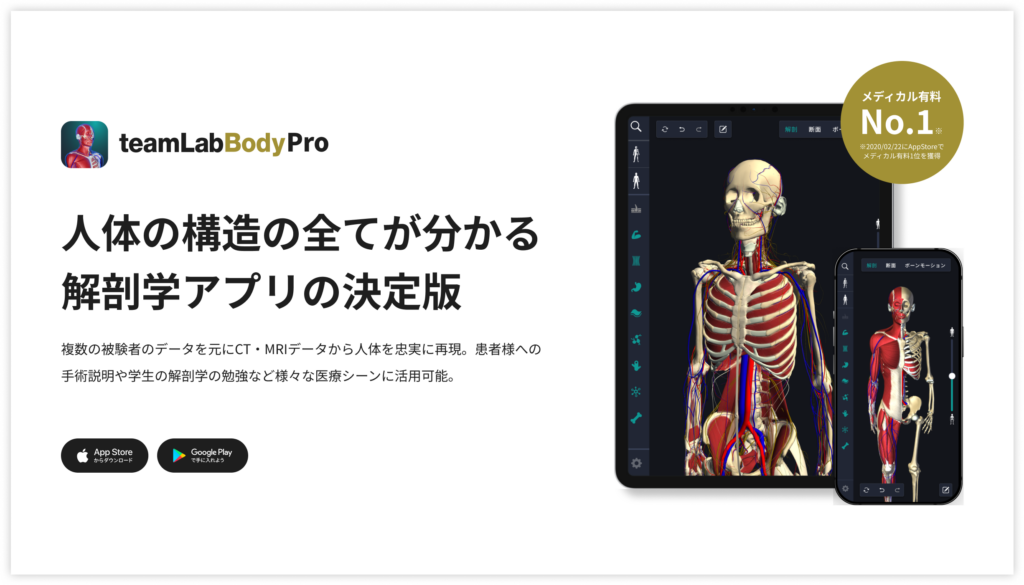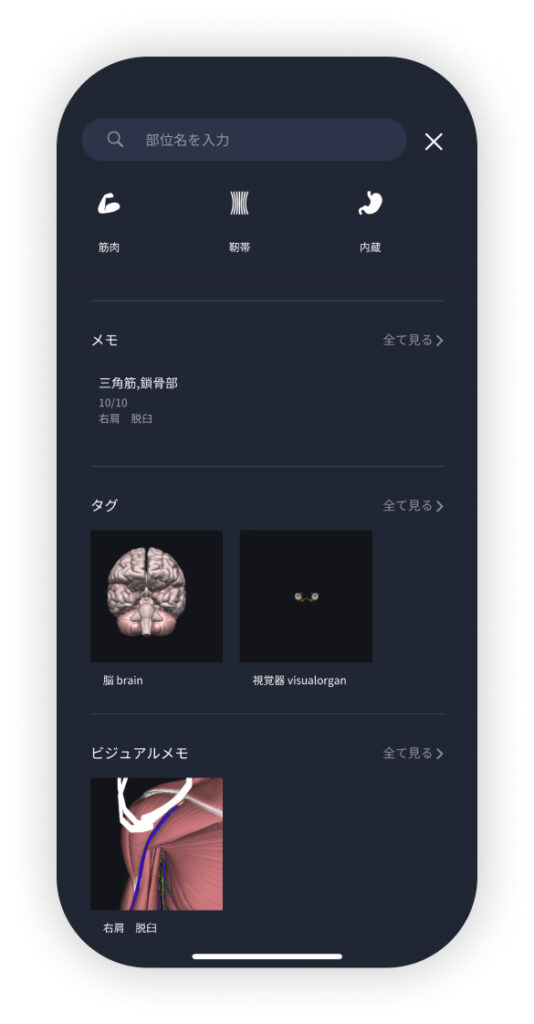beginning
In this article, I will explain effective study methods, starting with knowledge of specialized parts in human anatomy.
In human anatomy, it is necessary not only to memorize the names of various organs, muscles, and bones, but also to remember where they are located in the body. Therefore, it is necessary to learn as efficiently as possible.
I hope you will deepen your understanding even a little by reading this article and using the app.
Now, I'll explain the details about the “submandibular gland” and how to study human anatomy.
teamLab Body Pro Free Download
A 3D anatomy app that shows all the structures of the human body
Download teamLab Body Pro here!

What is the submandibular gland?
In the anatomy application, you can view a selection of anatomy 3D models. In this model, there are various observation methods such as surfaces, cross-sections, and nervous systems. This time, I'll explain using an anatomy application.
About the submandibular gland

The submandibular gland is one of the main salivary glands that secretes saliva into the oral cavity, and is located inside the lower jaw, near the corner of the jaw. Due to its size and location, this gland plays an important role as part of the main salivary gland along with the sublingual gland.
The submandibular gland mainly secretes digestive enzymes along with the water component of saliva to lubricate the oral cavity, assist digestion, and prepare for digestion of food. Saliva secreted from the submandibular gland also plays a role in keeping the oral cavity clean, protecting the oral mucosa, suppressing bacteria, and protecting teeth. In addition, saliva containing digestive enzymes is responsible for the phase in which food is first digested in the mouth, increasing the efficiency of digestion.
Study points
Anatomical understanding: location and structure of the submandibular gland
The submandibular gland is located inside the lower jaw, near the corner of the jaw, and secretes saliva into the oral cavity through the submandibular duct. It is necessary for learners to understand the positional relationship of the submandibular gland and grasp the relationship with neighboring structures (tongue, neck blood vessels, nerves). Deepening understanding of the size and position of the submandibular gland, and even the running of the submandibular duct, is essential for understanding the mechanism of saliva secretion and its function in the oral cavity. For anatomical learning, visual understanding of the submandibular gland and its related structures progresses by using 3D anatomy apps and human models. Also, it is important to learn how the submandibular duct supplies secretions into the oral cavity.
Functional understanding: salivation function of the submandibular gland
The main function of the submandibular gland is the secretion of saliva. Saliva secreted from the submandibular gland contains digestive enzymes and helps break down food. It also lubricates and cleans the oral cavity and helps eliminate bacteria and foreign matter. When learning, actually eating meals and consciously feeling salivation can help you understand the function of the submandibular gland in an experiential way. It is important to understand that submandibular secretions contain digestive enzymes and antibacterial substances, and these regulate the oral environment. Furthermore, by learning about the role of saliva in the oral cavity, you will be able to feel the effects of the submandibular gland on digestion and oral health.
Practical application: submandibular gland disease and its effects
The submandibular gland is associated with various diseases, such as sialolithiasis (a disease in which stones form in the salivary glands) and adenitis (inflammation due to infection). Sialolithiasis can cause swelling, pain, and discomfort in the oral cavity because saliva does not flow sufficiently within the submandibular gland. Adenitis is a condition where infection occurs in the submandibular gland and pus accumulates and is painful. Understanding these diseases is critical to understanding how the submandibular gland works and how abnormalities occur. For learning, along with the anatomy of the submandibular gland, it is also important to grasp treatments and prevention methods for diseases. When treating diseases related to the submandibular gland clinically, it is necessary to understand its anatomical structure and perform appropriate diagnosis and treatment according to the condition.
How to study human anatomy
I will explain specific study methods using human anatomy applications.
Check your past learning history and practice repeatedly
Here are the steps to check your anatomy learning history and practice iteratively effectively.
1. Check your learning history in the app
Reviewing your learning history with the application is an important step in effectively advancing anatomy learning. First, launch the app and go to the learning history section from the main menu. Many anatomy apps are designed to show your progress in the form of graphs and lists, so you can visually check which parts you've learned about and how much time you've spent.
By using this data, you can understand which areas you have strengths in and where you need to spend more time and effort. We also recommend using a dedicated tag or notebook function to mark areas you are particularly weak at or where you need to relearn. Regularly checking your learning history and looking back on past learning content will lead to efficient review and deepening understanding.
2.Make a plan for iterative learning
Making an efficient repetitive learning plan based on learning history is extremely effective in promoting knowledge retention. First, identify weak points and areas where you need to relearn. Next, arrange these study items into a weekly or monthly calendar and create a specific study schedule. By proceeding in a planned manner, you can learn each part evenly and avoid packing in a large amount of information at once.
Using a task management app or digital calendar to set study reminders is effective. Also, it's important to have the flexibility to regularly review progress and revise plans as needed. By having goals and proceeding with your studies in a planned manner, you can efficiently acquire anatomical knowledge.
3.Use 3D features to learn visually
By utilizing the 3D function, learning anatomy is easier to understand visually. The 3D model shows the structure of the human body three-dimensionally, and each part can be observed in detail. This makes it possible to intuitively grasp positional relationships between deep muscles and organs that are difficult to capture in a planar view. For example, you can learn even the smallest details by rotating specific muscles and bones and zooming in and out.
Also, there are many apps that have the function of displaying cross-sectional views of each part using a 3D model, which is useful for deepening understanding of internal structures. This diversity of visual information helps with memory retention and improves immediate responsiveness in tests and practice situations. By utilizing the 3D function and learning visually, you can learn anatomy knowledge more deeply and efficiently.
Use the memo function concretely

Make notes so you don't forget the things and points you've noticed while studying. The memo function can be used for different purposes, such as inputting text, saving images, and writing memos. Tag your notes to make them easier to review later.
Test your learning regularly in the form of quizzes
Regularly testing what you've learned in a quiz format is a very effective way to anchor your anatomy knowledge. Quiz-style tests help you objectively grasp your level of understanding and areas you lack while repeating knowledge.
For example, by using a learning app to conduct quizzes every specific period, you can reconfirm what you've learned and strengthen your memory. There are a wide range of quiz formats, such as multiple choice questions, fill-in-the-blank questions, and short answer questions, and each helps understanding from a different angle and develops the ability to utilize various types of knowledge.
Get feedback
If possible, get feedback from other learners and experts. It helps you find your own gaps in understanding and areas for improvement. You can also keep yourself motivated to learn by regularly testing yourself. Feeling a sense of accomplishment and progress increases motivation for continuous learning.
summary
This time, I explained how to study the “submandibular gland” using an application!
Thank you for reading this far.
I would be happy if reading this article helped you learn about anatomy.
Learning is a long, never-ending journey, but I sincerely wish you all the best. Let's continue to study together and work hard for the national exam!
Please look forward to the next blog.
teamLab Body Pro Free Download
A 3D anatomy app that shows all the structures of the human body
Download teamLab Body Pro here!





